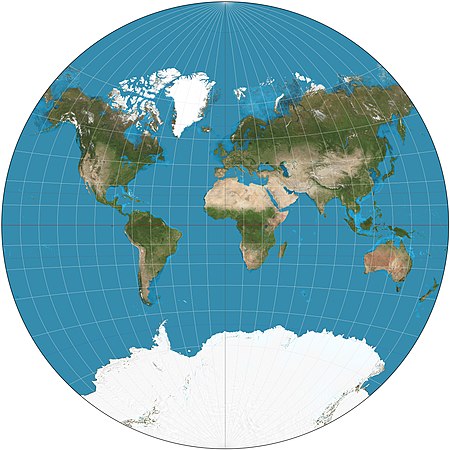| Revision as of 12:58, 2 March 2013 editAddbot (talk | contribs)Bots2,838,809 editsm Bot: Migrating 3 interwiki links, now provided by Wikidata on d:q1026877← Previous edit | Revision as of 09:53, 10 March 2013 edit undoBG19bot (talk | contribs)1,005,055 editsm WP:CHECKWIKI error fix for #61. Punctuation goes before References. Do general fixes if a problem exists. - using AWBNext edit → | ||
| Line 2: | Line 2: | ||
| The '''van der Grinten projection''' is a compromise ] that is neither ] nor ]. It projects the entire Earth into a circle, though the polar regions are subject to extreme distortion. The projection was the first of four proposed by Alphons J. van der Grinten in 1904, and, unlike most projections, is an arbitrary geometric construction on the plane. It was made famous when the ] adopted it as their reference map of the world from 1922 until 1988.<ref>''Flattening the Earth: Two Thousand Years of Map Projections'', John P. Snyder, 1993, pp.258-262, ISBN 0-226-76747-7.</ref> | The '''van der Grinten projection''' is a compromise ] that is neither ] nor ]. It projects the entire Earth into a circle, though the polar regions are subject to extreme distortion. The projection was the first of four proposed by Alphons J. van der Grinten in 1904, and, unlike most projections, is an arbitrary geometric construction on the plane. It was made famous when the ] adopted it as their reference map of the world from 1922 until 1988.<ref>''Flattening the Earth: Two Thousand Years of Map Projections'', John P. Snyder, 1993, pp.258-262, ISBN 0-226-76747-7.</ref> | ||
| The geometric construction given by van der Grinten can be written algebraically<ref>, ] Professional Paper 1395, John P. Snyder, 1987, pp.239-242</ref> |
The geometric construction given by van der Grinten can be written algebraically:<ref>, ] Professional Paper 1395, John P. Snyder, 1987, pp.239-242</ref> | ||
| :<math>x = \frac {\pm \pi \left(A\left(G - P^2\right) + \sqrt {A^2 \left(G - P^2\right)^2 - \left(P^2 + A^2\right)\left(G^2 - P^2\right)}\right)} {P^2 + A^2}\,</math> | :<math>x = \frac {\pm \pi \left(A\left(G - P^2\right) + \sqrt {A^2 \left(G - P^2\right)^2 - \left(P^2 + A^2\right)\left(G^2 - P^2\right)}\right)} {P^2 + A^2}\,</math> | ||
Revision as of 09:53, 10 March 2013

The van der Grinten projection is a compromise map projection that is neither equal-area nor conformal. It projects the entire Earth into a circle, though the polar regions are subject to extreme distortion. The projection was the first of four proposed by Alphons J. van der Grinten in 1904, and, unlike most projections, is an arbitrary geometric construction on the plane. It was made famous when the National Geographic Society adopted it as their reference map of the world from 1922 until 1988.
The geometric construction given by van der Grinten can be written algebraically:
where takes the sign of , takes the sign of and
Should it occur that , then
Similarly, if or , then
In all cases, is the latitude, is the longitude, and is the central meridian of the projection.
Notes
- Flattening the Earth: Two Thousand Years of Map Projections, John P. Snyder, 1993, pp.258-262, ISBN 0-226-76747-7.
- Map Projections - A Working Manual, USGS Professional Paper 1395, John P. Snyder, 1987, pp.239-242
References
This cartography or mapping term article is a stub. You can help Misplaced Pages by expanding it. |


 takes the sign of
takes the sign of  ,
,  takes the sign of
takes the sign of  and
and





 , then
, then


 or
or  , then
, then


 is the longitude, and
is the longitude, and  is the central meridian of the projection.
is the central meridian of the projection.